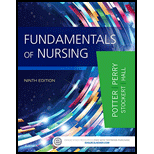
Concept explainers
To explain:
Better care for cancer survivors using the experience faced by a cancer patient.
Case summary:
Do you have a friend or your family member, who has suffered from cancer and wants to discuss about it? In this case, ask the person to explain about his or her experience and what the person would recommend to help you regarding better care services to cancer survivors.
Explanation of Solution
The major adverse effects of cancer treatments are experienced by cancer patients are myelosuppression or bone marrow suppression, immune suppression, gastrointestinal distress, cardiovascular toxicities, osteoporosis, erectile dysfunction, fatigue, loss of appetite, sexual and cognitive impairment, dry mouth, weakness, anemia, nausea, vomiting, sleep disturbances, apathy, and hair loss.
Cancer is considered as a chronic disease due to its aggressiveness and late effects of treatment. The late effects of cancer and its treatment depend on the stage of cancer, type of condition, and the duration of the treatment period. The common late effects of chemotherapy are fatigue, early menopause, heart problems, cognitive impairment, muscle weakness, secondary cancers, problems in the kidney, lung, bone, joint, and nerve.
We can suggest the cancer patient to undergo the survivorship care plan, which contains an organized approach about treatment, diagnosis, and caring of the cancer patient. The important components of cancer survivorship care include the prevention and detection of recurrence, surveillance of the spread of cancer, the consequences associated with cancer and its treatment, and coordination among health care providers and caregivers.
Based on this information, follow-ups, check-ups, and assessment of treatment-induced delayed effects are important to treat the patient. Hence, analysing the continued symptoms of cancer and survivorship care plan can help to provide proper care for cancer survivors.
Want to see more full solutions like this?
Chapter 8 Solutions
Fundamentals of Nursing, 9e
- true or false any practice employee is authorized to and should communicate collection guidelines with practice?arrow_forwardrtrue or false equesting a listing of specific creditreferences during patient intake os an acceptable business practice?arrow_forwardgive an overview on the respiratory assessmentarrow_forward
- explain an abdominal exam?arrow_forwardDiscuss β -Lactam antibiotics under the following subheadings Classifications of penicillins Classification of Cephalosporins General Mechanism of Actions Clinical Indications of penicillins and cephalosporins Adverse effects of β-lactamsarrow_forwarda. Define neoplasm b. Differentiate between benign and malignant tumours c. Describe the molecular basis of cancerarrow_forward
- differentiate the extra heart sounds S3,S4, murmurs and gallopsarrow_forward• Define shock and list types of shock • Discuss pathogenesis of septic shock. • Enumerate the stages of shock. • Define oedema and describe the pathophysiologic mechanisms of oedema with examples.arrow_forwardDiscuss Hypertension under the following headings: Definition Diagnosis Non-pharmacological intervention Drugs Classification Management of a Hypertensive emergencyarrow_forward
- Explain how the answer could be 2 or 1.8 WITHOUT changing the questionarrow_forwardoverview of the neurological system, cranial nerves and what part of the body it innervatesarrow_forwarddifferentiate structure and function of the peripheral vascular system. what are the normal and abnormal findings of the peripheral arterioles and peripheral venous systemarrow_forward
 Phlebotomy EssentialsNursingISBN:9781451194524Author:Ruth McCall, Cathee M. Tankersley MT(ASCP)Publisher:JONES+BARTLETT PUBLISHERS, INC.
Phlebotomy EssentialsNursingISBN:9781451194524Author:Ruth McCall, Cathee M. Tankersley MT(ASCP)Publisher:JONES+BARTLETT PUBLISHERS, INC. Gould's Pathophysiology for the Health Profession...NursingISBN:9780323414425Author:Robert J Hubert BSPublisher:Saunders
Gould's Pathophysiology for the Health Profession...NursingISBN:9780323414425Author:Robert J Hubert BSPublisher:Saunders Fundamentals Of NursingNursingISBN:9781496362179Author:Taylor, Carol (carol R.), LYNN, Pamela (pamela Barbara), Bartlett, Jennifer L.Publisher:Wolters Kluwer,
Fundamentals Of NursingNursingISBN:9781496362179Author:Taylor, Carol (carol R.), LYNN, Pamela (pamela Barbara), Bartlett, Jennifer L.Publisher:Wolters Kluwer, Fundamentals of Nursing, 9eNursingISBN:9780323327404Author:Patricia A. Potter RN MSN PhD FAAN, Anne Griffin Perry RN EdD FAAN, Patricia Stockert RN BSN MS PhD, Amy Hall RN BSN MS PhD CNEPublisher:Elsevier Science
Fundamentals of Nursing, 9eNursingISBN:9780323327404Author:Patricia A. Potter RN MSN PhD FAAN, Anne Griffin Perry RN EdD FAAN, Patricia Stockert RN BSN MS PhD, Amy Hall RN BSN MS PhD CNEPublisher:Elsevier Science Study Guide for Gould's Pathophysiology for the H...NursingISBN:9780323414142Author:Hubert BS, Robert J; VanMeter PhD, Karin C.Publisher:Saunders
Study Guide for Gould's Pathophysiology for the H...NursingISBN:9780323414142Author:Hubert BS, Robert J; VanMeter PhD, Karin C.Publisher:Saunders Issues and Ethics in the Helping Professions (Min...NursingISBN:9781337406291Author:Gerald Corey, Marianne Schneider Corey, Cindy CoreyPublisher:Cengage Learning
Issues and Ethics in the Helping Professions (Min...NursingISBN:9781337406291Author:Gerald Corey, Marianne Schneider Corey, Cindy CoreyPublisher:Cengage Learning





